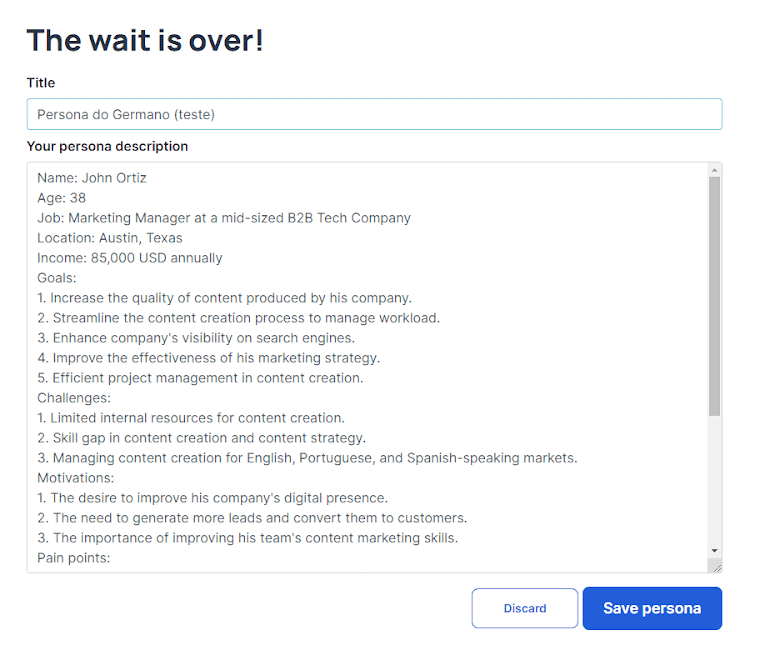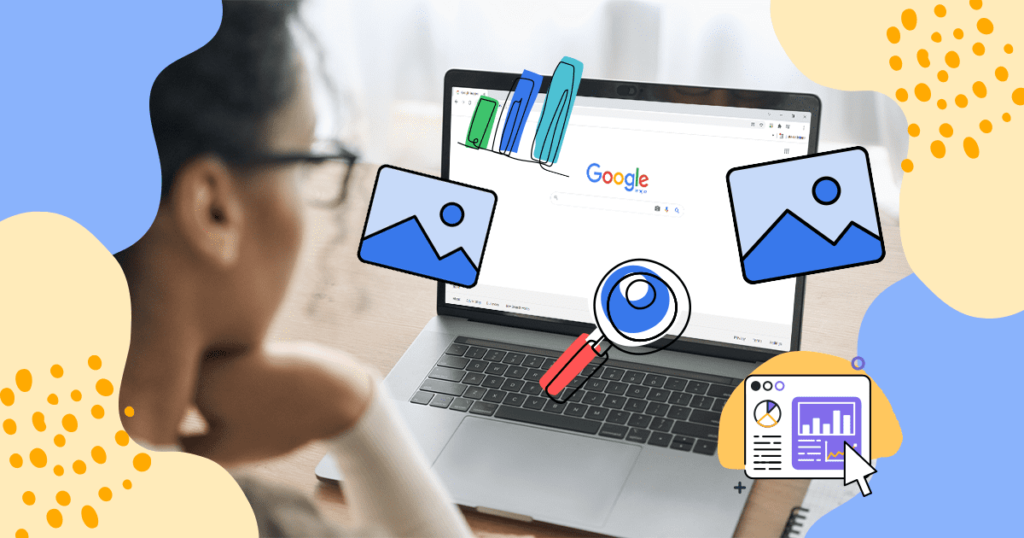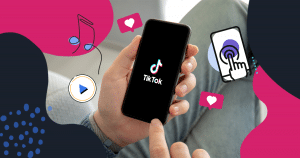It’s fair to say that AI has been the biggest surprise of the last year. Even though many people knew it was about to become a reality, I don’t think most of us could truthfully say we understood the immediate impacts it would have on our lives.
And, without question, one of the areas that experienced the most changes thanks to generative artificial intelligence is digital marketing.
From copywriting to image sourcing, everything changed.
So, it’s perfectly understandable that many marketers still feel lost and uneasy when producing their content.
As a small disclaimer, I used to be terrified of AI. Yes, I was (and to some extent, I still am) one of those people.
Since I work with project management in marketing, I’ve learned to accept that there’s nowhere to run. We can adapt to it or stay behind as the world progresses without us. And to do so, I did what I do best: started a personal project to test and use AI in my job, both from a managerial standpoint and a content production standpoint.
Now, I want to share a few of those insights with you so I can prove that these tools can help you in many ways other than just producing copy.
How can AI work with me?
A common misconception is that AI works for us. For you to have the best possible results, try and see these tools as a coworker who works with you. By that I mean: use it to increase productivity and quality, not to create everything from scratch.
What sets and will continue setting your content and company apart from your competitors is your creativity and humanity. Meaning that every content we create must have our customers and their needs in mind.
As much as artificial intelligence can understand and analyze what people are looking for, which keywords they are using, and which content performs better, they are not able to understand your persona’s pains and challenges. Only another human can.
Also, make no mistake: Google might not penalize you for using AI-created content, but it will lower your ranking if your content is made primarily for the algorithm.
Your goal should always be to help and inform people if you want to achieve great content performance. And ChatGPT, as of now, still cannot tell the difference between those two goals.
You need to be very careful with your prompts if you don’t want to end up with content that only engages crawlers.
As our VP of Marketing, Giu Caltabiano, said in his amazing article on the topic: “AI commoditizes content creation, while at the same time, it makes handmade content more valuable.”
We can also look at writers’ positions during the recent Hollywood strike. The idea was never to rule out the use of these tools, but to have it as an ally to write better and complement human creativity and hard work.
That being said, there’s much you can do without going straight to asking ChatGPT to produce your content.
- Use AI to aid your content strategy for the next year
This is my favorite way of using AI. It has a lot of useful information in its database and can be extremely helpful in all steps of your strategy journey, from creating a persona to selecting keywords.
Let’s begin with the persona. We have two traditional ways of creating one: you can do a proto persona, using the information and inferences you have about your target audience, or you can go with a data-driven approach.
This tends to be one of the challenges of my customers: personas need to be specific, not generic. If you have too broad a persona, then you’re closer to having a target audience.
Here at Rock Content, we usually recommend you try and go for the data-driven one since you can tailor your research to your specific customer base and focus.
However, we do understand this is not always easy or even possible for a multitude of reasons. So, you can use AI to help you create or update your persona and still have it based on general data.
A good example of this is the AI Persona Builder. With just a handful of inputs such as your business model (whether it is B2B or B2C), the URL of your website, and a basic understanding of your target audience’s pain points, the AI Persona Builder will provide you with a complete persona, including age, income, profession, location, goals, challenges, motivations and pain points.

Even better: you can create as many personas as you need.
If your brand has multiple products or services, you can link to the specific page for each one, and input the pain points accordingly. This way, the AI will be able to provide you with a complete set of personas tailored to each of your needs.
If you’re used to a lot of work and taking many days to create a persona, give it a try. It can do wonders for your marketing strategy for the next year.
Do you already have a persona? Give it a try and see how the proposed results can add/update what you already have.
If this seems like something you might have a use for, you can check this article by the amazing Content Strategist Germano Ferreira, where he explains in depth all the advantages of using an AI-generated persona.
But this is not the end-all-be-all of what AI can do for your content strategy. Where it really shines is when it comes to keyword research.
- Machine learning and keyword research: a match made in Heaven
The main advice I always give my clients when it comes to creating a keyword list is to put yourself in your persona’s shoes.
If you’re the one looking for the kind of service or product you have, what would you research and how? This is a simple and yet great first step to begin mapping out possible keywords.
However, when you need to advance your SEO strategy, that is not enough anymore.
The main reason is that customers are not predictable: they can search for the same thing in many different ways. Machine learning can help you understand which sentences and words people are using to get to what you have to offer.
With its help, you can not only map out which keywords to use, but also weigh in how competitive these words are, what is the cost per click of each, and their search volume.
This way you can guarantee that you’ll consider the most important metrics when creating your keyword list.
One of the coolest tools I’ve seen for this is SurferSEO.
This is a very complete tool that helps you optimize your SEO strategy like no other. It allows you to plan your content according to the keywords you want to tackle, audit previous articles, and give you access to a handy editor you can use to optimize your writing as you do it.
You can use it through a subscription directly on their website or through WriterAccess, where it’s available to help you create a complete content brief based on a phrase and map out the best content opportunities.
It allows you to map and analyze the best keywords for your theme, suggests topics (including possible subheaders), and gives you a complete overview of the SEO-related opportunities.
- Understand which contents will be a better fit with your keywords
Okay, you have your persona and a keyword list. Now what? How can AI and machine learning help you when it comes to combining these two and optimizing your content?
These tools can analyze your inputs and their data and provide you with useful information to create a content brief or content outline. What once demanded a lot of research and maybe days of analysis can now be done within minutes.
Usually, these tools use inputs such as personas, your website’s URL, competitors, and keywords to find the best content opportunities.
I have a great case study about AI Content Wizard: one of my customers has a one-person marketing team and they work mapping and creating content in multiple languages and to multiple audiences, all of it while being in a very competitive industry.
They were fairly advanced when it came to their content creation when we began our consultancy.
When I suggested this tool to them, we used SpyFu to map out the keywords their competitors were using and highlighted the ones that made the most sense to my client.
Then we went to the AI Content Wizard with a list of the competitors and the main keywords this person had previously mapped through SEMRush, and it came up with three theme suggestions, along with their content briefs, subheadings, the suggested primary keyword that should be used in this content, as well as its difficulty and search volume.
This customer managed to go from researching their competitor’s strategies to having a complete brief that would fill in the gaps in the industry within less than 10 minutes.
For a one-person team, this is a huge accomplishment! Now, this person was able to focus their time on other important activities they were neglecting to be able to produce content.
A tool like this can help you speed up your content strategy like nothing else.
And what if the AI’s suggestion does not align with your goals or preferences? That’s simple. You can always refresh the page and get a new theme, all while signaling to it that this is not what you’re looking for, and letting machine learning do the rest.
The more you use these tools, the better they’ll understand your needs and wishes, and the better your suggestions will turn out.
- Ask for help with topics to cover!
Up until now, I’ve used the example of leaner teams who don’t have the time or resources to plan out their content and need help filling in the gaps.
However, there’s one point where all the teams, big and small, converge: what themes should you cover?
It’s usually easy at first. You are still starting to work on your strategy, you have tons of ideas about what you want to teach your customers and how your products and services can help them. But what happens when you are a few months or years in, and you have already used up all your creativity? How do you find new and relevant topics?
Well, by now you must be able to guess what my answer is going to be.
Artificial Intelligence is capable of getting ideas related to your blog and identifying content opportunities that your readers might be willing to explore next.
This is the case for WriterAcess’s AI Content Idea Generator: you can type your link and, based on your previous orders inside the platform, it’ll suggest five or six topic suggestions for you to use.
The best part here is that it gives you the idea, the starting point. You can adapt it to your needs and use creativity to bring this idea to your brand’s reality.
Final Remarks
AI can be scary and involve a lot of uncertainty. But for each artificial intelligence tool that is created, there’s a way human creativity can work around it to make it safer, specific, and more helpful to our daily needs.
Write down your main challenges in content production today. Which of those are the most time-consuming, and ask your AI co-worker for help. You don’t need to change everything about the way you work or produce content: you can just make your life a little easier.







